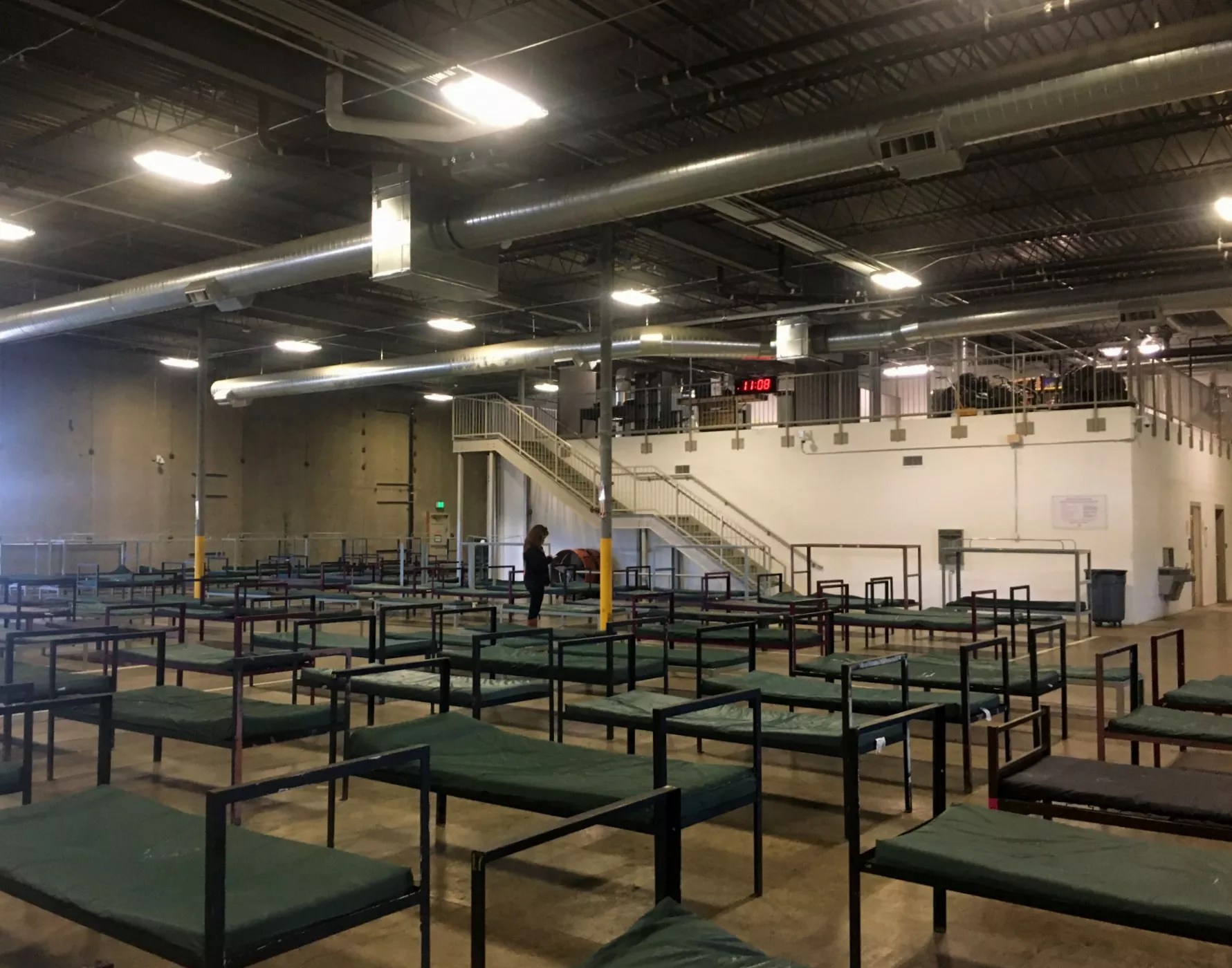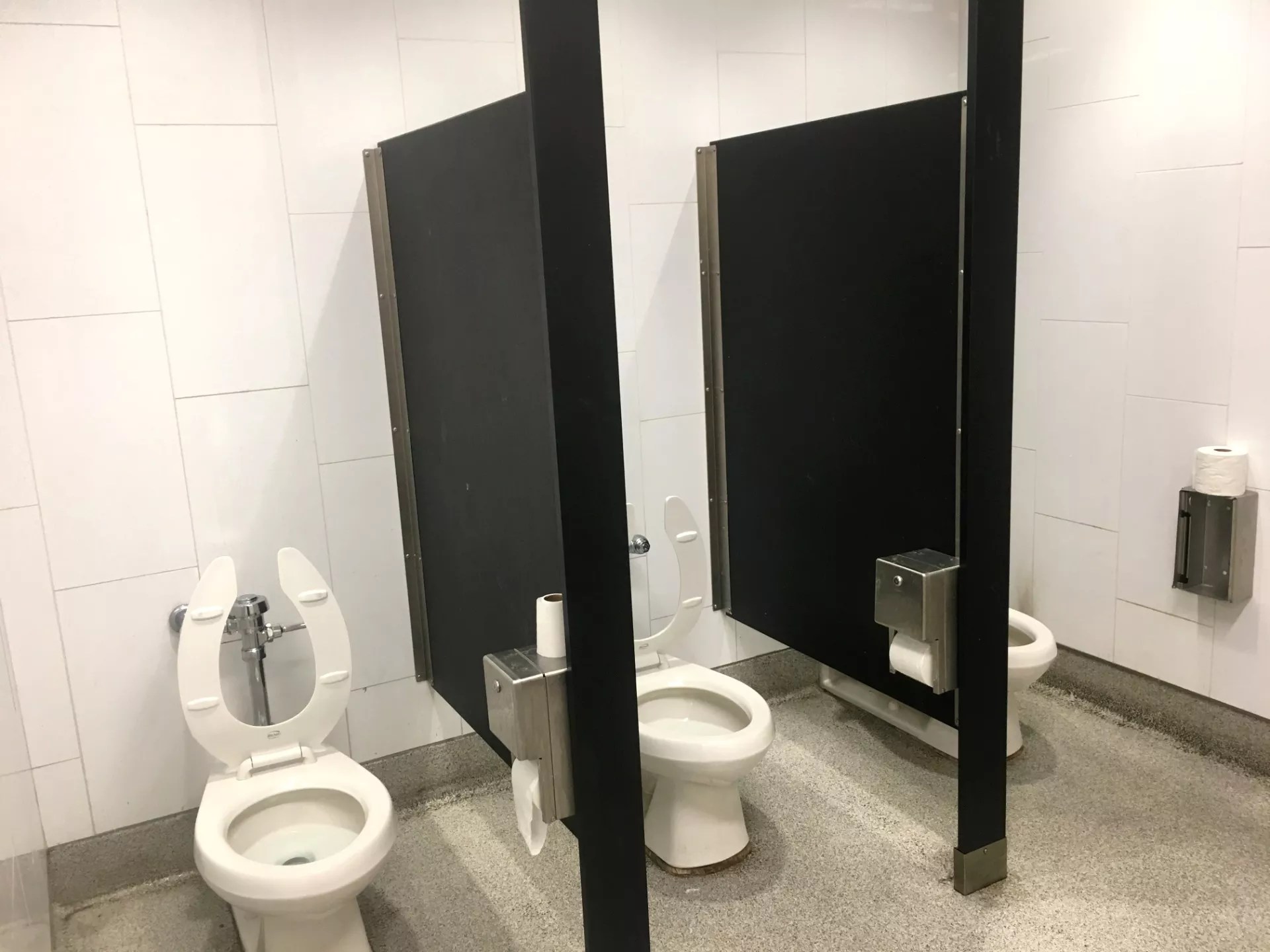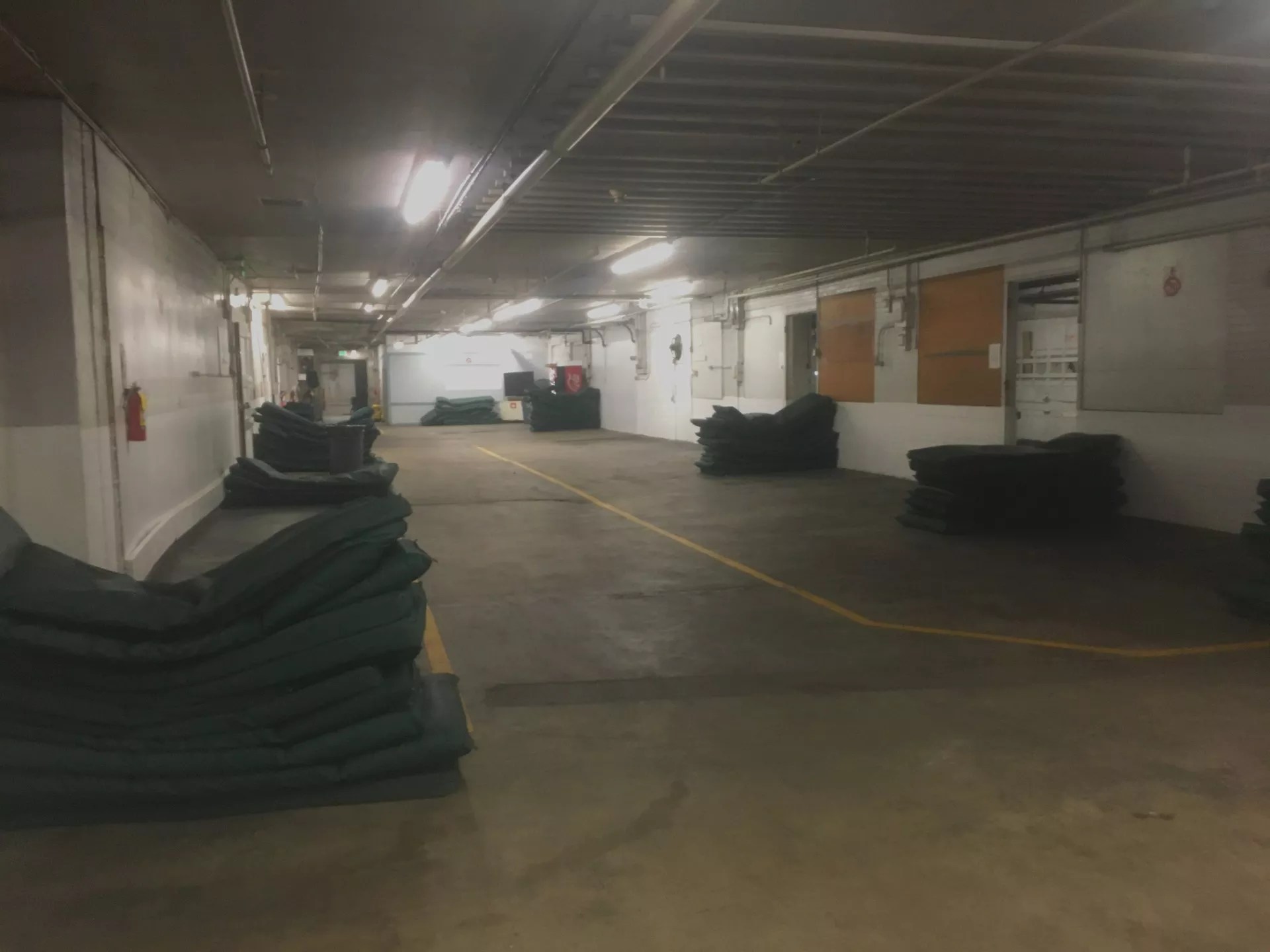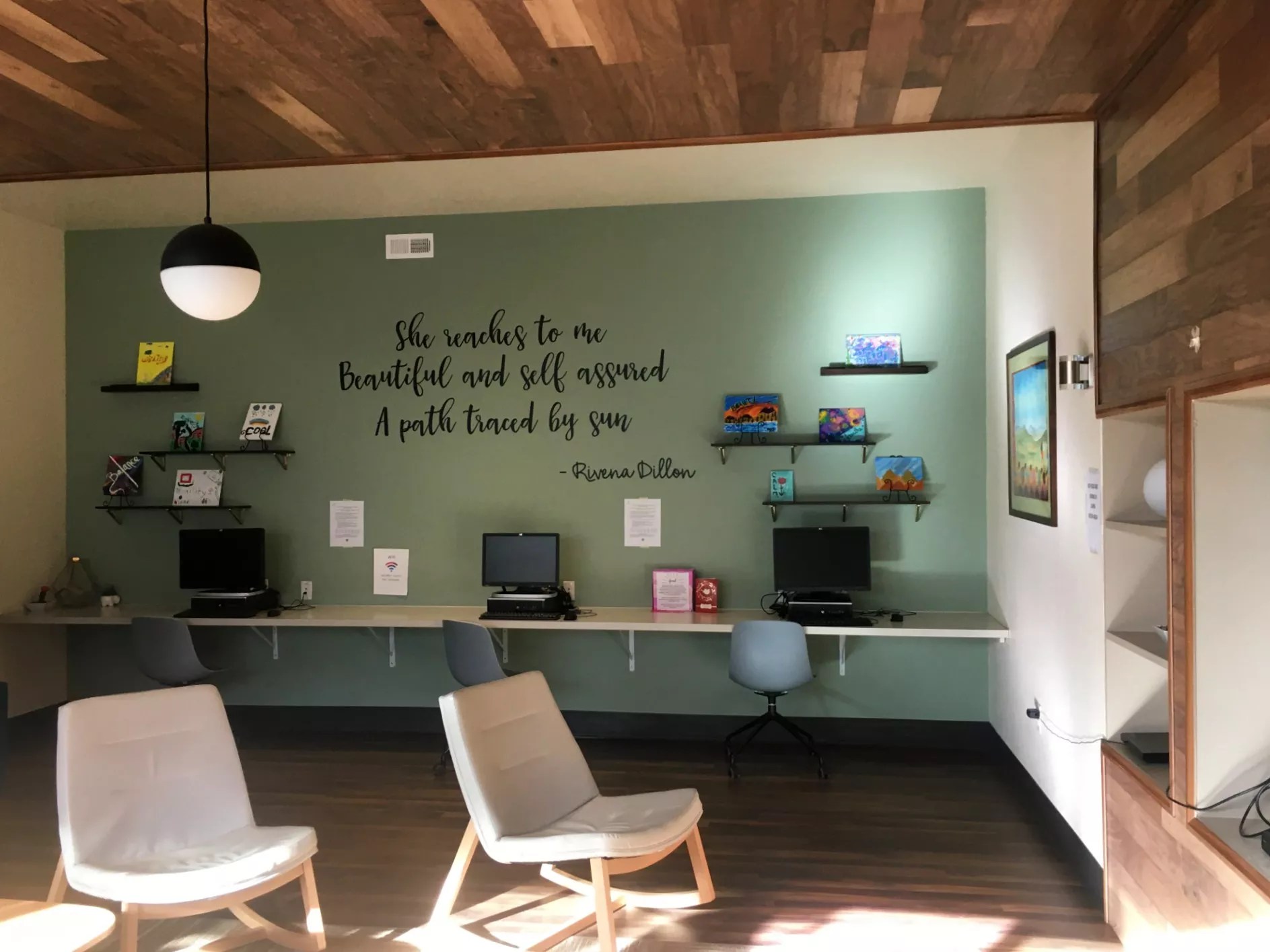
Sara Fleming

Audio By Carbonatix
From the outside, there is no visible difference between the Denver Rescue Mission’s 48th Avenue Shelter and the other large warehouses that surround it. But while other buildings in the industrial corner of northeast Park Hill hold construction supplies, bulk food to be distributed at Safeway and other such goods, the 48th Avenue Shelter houses row upon row of beds that sleep up to 500 men experiencing homelessness in Denver every night.
Before the city purchased the 48th Avenue Shelter, which replaced its former overflow shelter, in 2017, it was a warehouse, then a marijuana grow that never took off. Denver Rescue Mission now runs it as a permanent emergency shelter. Homeless men can generally get a bed the night they request one by showing up at the Denver Rescue Mission’s downtown location between 5:30 and 9:30 p.m. to catch a bus that shuttles them to the 48th Avenue facility. Once there, they don’t get much beyond the bare bones: a thin blanket, a roof over their heads, some outlets to charge their electronic devices, and hundreds of roommates in close proximity.
On Thursday, January 9, eleven Denver City Council members toured the 48th Avenue Shelter, along with seven other shelters, after council approved $6.89 million in funding for improvements to such facilities in December. While members got a chance to look at conditions, they didn’t see the shelters actually operating; tours were conducted during the daytime, when there were no guests. Chris Conner, the director of homelessness resolution with the city’s new Department of Housing Stability, says tours during evening hours would have disrupted the shelters’ normal operations.
Conditions and accessibility of shelters are especially crucial issues as the city appeals a December 27 court ruling that deemed Denver’s camping ban unconstitutional. In his ruling, Denver County Court Judge Johnny Barajas wrote that “as long as there is no option of sleeping indoors, the government cannot criminalize indigent, homeless people for sleeping outdoors, on public property, on the false premise they had a choice in the matter.” While Denver’s shelters nearly almost always operate below capacity, the judge recognized after hearing testimony from five current and formerly homeless individuals that certain populations have “limited access to adequate shelter,” rendering them without many options to sleep indoors. Some who testified said they had been shut out of shelters after working a late shift and missing curfew. Others felt strained by the environment, describing shouting matches in the middle of the night. Still others said they struggled after being separated from their spouses or pets.
Their testimony might befuddle those who’ve never experienced homelessness. Wouldn’t a night that included a hot meal and a roof be better than one spent outside on the streets? For many, that’s the case at least some of the time – thousands of homeless residents enter Denver’s shelter system each night.
But other unhoused people say shelters can be more traumatizing and less safe than the streets. After touring the shelters, Lisa Calderón, Councilwoman Candi CdeBaca’s chief of staff, funded partially by the city. The Department of Housing Stability partners with nonprofit providers (some faith-based, some secular), identifies areas that need more investment (such as services or building improvements), and contracts with providers for those projects and programs. Overall, Conner says, shelters in the city’s system provide 1,780 beds each night for single adults, with a few hundred more mats available in the case of an overflow.
Some shelters are designated as “emergency” shelters, in which individuals who meet the demographic criteria will get a bed the night they request one, as long as they meet the shelter’s curfew. There are three big emergency shelters in Denver: the Salvation Army’s Crossroads Shelter for men, the 48th Avenue Shelter for men, and Catholic Charities’ Samaritan House for women. (The Delores Project provides a small number of emergency beds for women and transgender individuals, and Urban Peak provides a small number for youth ages 15 to 21.) Other shelters provide transitional housing, which includes more supportive services such as case managers and housing counseling. But transitional housing usually requires people to meet certain criteria and either sit on a waiting list or enter through a lottery.
The requirements and expectations shelters have of their guests vary. Some shelters are “dry,” requiring strict sobriety; others are “wet,” in which individuals can drink at their beds if they wish. Most of Denver’s shelters are “damp,” meaning those who have been drinking or using drugs are allowed in, but they’re not allowed to use on the premises.
Shelter providers offer different kinds of services. For example, the Denver Rescue Mission offers a “Next Step” program at its Lawrence Street location that provides in-house services. But even if potential residents wanted to commit to the requirements of the program – sobriety, a host of shelter chores, and staying for fifty days while meeting consistently with a case manager – they would have to wait for availability. Those seeking emergency shelter line up in the Lawrence Street Community Center, a cafeteria-style hall during working hours and a de facto Greyhound station by night. They can eat a meal from the soup kitchen and eventually board a bus out to the 48th Avenue Shelter or Holly Street, a men’s overnight shelter that allows residents to reserve the same bed for a week.

Staffers say the bathrooms at the 48th Avenue Shelter have no doors in order to deter drug use by clients.
Sara Fleming
One concern that unhoused people repeatedly raise about shelters is privacy. At the 48th Avenue Shelter, for example, beds are lined up in rows in two large, open rooms. Showers are communal, and bathrooms have no stall doors, which staff say deters drug use. In shelters without personal lockers, such as Crossroads and 48th Avenue (the latter will install 500 lockers under beds in 2020), people have to be vigilant about their belongings to ensure they aren’t stolen. One witness in the camping ban case, Roy Browne, testified about his experience in men’s shelters. “If you consider people being able to walk up, look at you when you’re sleeping, walking up behind you in the shower, pull the curtain back, checking you out and watching you – if that’s privacy, that’s a very small, minuscule definition,” he said.
Many shelters have night curfews and close early in the morning. The Denver Rescue Mission stops running buses at 9:30 p.m. and Crossroads closes at 11 p.m., but both will take people after-hours if they’re accompanied by a police officer or service worker. 48th Avenue wakes residents up and begins busing them back to its downtown Lawrence Street Shelter location for breakfast at 5 a.m. Catholic Charities runs buses at 7 a.m.
“The fact that they’re sitting empty all day long is a problem because they’re policing people all day long,” CdeBaca says. Denver Rescue Mission’s day shelter at Lawrence Street, in her view, “was extremely depressing, looking at people who were visibly ill on benches without backs, heads on tables, no ability to lie down. It made perfect sense to me why someone would lie down in a tent outside instead.”
There are no shelters that allow heterosexual couples without children to sleep together. It can also be hard to find a room for families with children who want to stick together. There are 25 rooms for families in Samaritan House and twenty at Salvation Army’s Lambuth Family Center, but they are constantly full and have long wait lists. Volunteers of America runs a motel for families experiencing homelessness, and the city can provide motel vouchers on a limited emergency basis.

A “bed” is really a mat on the floor in the emergency wing of Salvation Army’s Crossroads shelter.
Sara Fleming
The shelter system has extremely limited options for a huge subset of the population: those who have limited mobility. The Denver Rescue Mission is the largest provider for homeless men, but its Lawrence Street Shelter isn’t ADA-accessible, and neither are the buses that run from it to the 48th Avenue and Holly Street shelters. Councilman Chris Hinds, who uses a wheelchair, had to wait outside for colleagues on Thursday’s tour.
“The homeless population nationally – and Denver reflects this – has a disproportionately high percentage of people with disabilities, because people with disabilities can’t work as many jobs,” Hinds explains. In Los Angeles County, for example, 19 percent of individuals experiencing unsheltered homelessness and 43 percent experiencing chronic homelessness have a physical disability.
Samaritan House, the biggest emergency provider for women, is ADA-accessible. But currently, the only ADA-compliant emergency shelter for men in Denver is the Salvation Army’s Crossroads Shelter, a warehouse across the street from gleaming RiNo luxury apartments and high-end yoga studios. And yet the part of the facility that accommodates walk-ins consists mostly of mats on the floor, with only a handful of raised beds that a person with a disability could easily access. Eric Wilkerson, the Salvation Army “Captain” leading the tour, was frank that the Salvation Army wants to provide shelter to as many people as possible. “Safety comes first, comfort comes later,” he told the group. If someone with a disability is at all able to get themselves off the floor in the morning, they can expect to find themselves sleeping on it.
“It blows my mind to think that we’ve been granting dollars to those entities for so long and had never had an interest in whether or not they were accessible,” CdeBaca adds.
Not all Denver shelters are bare-bones warehouses with limited services. The Delores Project specifically designed its building to ease the trauma of homelessness, with warm lighting, comfortable furniture, soft color palettes, and plenty of space for each guest to securely store their belongings. Its mission includes “respect, hospitality and dignity for each guest.” The building itself is bright, spacious and new, and its lobby looks more like a luxury apartment complex than a homeless shelter. It has a gleaming kitchen with inspirational sticky notes on the walls, a library and a communal media room. Guests are allowed to personalize their own beds (equipped with Tempur-Pedic mattresses) with individual covers and comfort items. For those who’ve committed to an extended stay, it offers a personalized supportive services program.

The architecture firm that designed Delores Project used trauma-informed outlook to give it a welcoming, dignified appearance.
Sara Fleming
“Things do look amazing there,” Conner says about the Delores Project. “It’s not so much that it emerges as this luxury facility, but a more functional facility. It’s emotionally functional for the people that are accessing it. It’s hard to move forward in an environment that you feel terrible in.” Conner says the city encourages other providers to prioritize safety and dignity. At the same time, there are limited resources, and not all providers have the ability to redesign a trauma-informed building. “What’s trauma-informed and doable in one environment and one group may look different from another,” he says.
The funding approved by city council in December for improvements will go toward making the Denver Rescue Mission’s Lawrence Street Center ADA-compliant. An earlier package of funds will help make HVAC improvements at Crossraods, and replace mats with beds. The most recent funding will support deeper case management efforts there, with the eventual hope to become a 24/7 shelter. The money will also go toward more supportive services – including outreach, behavioral health case managers, peer navigators, rapid rehousing and substance-abuse treatment – at the Denver Rescue Mission, Crossroads, the St. Francis Center, Urban Peak and a forthcoming Volunteers of America shelter for older homeless women.
At the same time, the city is trying to move away from seeing shelters as the fix to homelessness, Conner explains: “We don’t want a system that’s based on solving somebody’s night-to-night crisis. We want a system that focuses on rehousing opportunities. We’d rather see stability than shelter.”